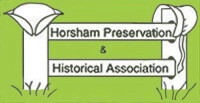Penrose-Strawbridge Farm
The Penrose-Strawbridge Farm is located on the southwest side of County Line Rd. in Horsham Township, Montgomery County, and is part of the Horsham Township Park System. It is located next to Graeme Park, the estate of colonial Governor Sir William Keith, which is now a state park and museum. Both properties – in addition to much of the surrounding area – were part of Keith’s 1734 acre137 estate, which he called Fountain Low.
Restoration of the Penrose-Strawbridge Farmhouse by HPHA is nearing completion.
Keith acquired the land in a round-about way from the estate of Samuel Carpenter who had purchased 5000+ acres (most of what would become Horsham Township) from William Penn. His purpose in developing the property was to malt grain, distill spirits and brew beer. We believe some small quantity of whiskey was produced but overall this plan failed. There is physical evidence that the c1721 cabin may have been involved in this endeavor, possibly as a distillery. The property was then acquired in 1735 by Keith’s son-in-law, Dr Thomas Graeme who renamed it Graeme Park.
Graeme Park has had numerous sizes and configuration since 1720. It was owned by the Penrose Family from 1801-1920 and from 1920-1996 by the Strawbridges.
Between 1929 and 1951 the Strawbridges acquired an additional 110 acres through several purchases. The last, in 1951, was for 4.435 acres from Mary Penrose Carothers, the last remaining child of Abel and Hannah Penrose on September 26, 1951. At this point the farm encompassed 300 acres.
The Korean War and the fear of Communism during the Cold War led to expansion of the adjacent Willow Grove Naval Air Station to allow the base to handle jets. The U.S. government acquired 31.855 acres of the farm in 1953 through condemnation and purchased another 41.49 acres in 1957. The Strawbridges, like the Penroses before them, recognized the historical significance of the Keith House. Both families had preserved the building and the Strawbridges feared that it might eventually be sacrificed for the continuing expansion of the base, so in 1958 they sold 42 acres of the estate to the state of Pennsylvania. This land included the Keith House which was later named a National Historic Landmark in 1963. This land retained the name “Graeme Park” and is now under the jurisdiction of the Pennsylvania Museum and Historical Commission and managed by the Friends of Graeme Park. The c1829 barn is now the Visitor’s Center for this park.
Mr Strawbridge passed away in 1968 and control of the property passed to Margaret Strawbridge. She wanted to preserve the remaining 103 acres of the farm and had further discussions with PMHC about selling the estate to PMHC at fair market value but it seems that PMHC was hoping for another donation.138 PMHC did not purchase the property and Mrs Strawbridge, for reasons unknown, did not donate the property to them, but instead sold a half-interest to the Natural Lands Trust for $1 in 1986. She was allowed to remain on the property and the remaining interest in the farm passed to the Trust upon her death in 1996.
The Trust took over the property but was not interested in preserving the buildings so they sold the property to Horsham Township in 1997 The estate is adjacent to the present 42 acre Graeme Park -separated by the driveway from County Line Road – and is known as The Penrose Strawbridge Farm at Graeme Park. The Strawbridge house is a Contributing Resource to the National Historic Landmark Keith House (a building, site, structure, or object adding to the historic significance of a property.)
The buildings on this site, including the c1721 Penrose-Strawbridge House, are located on 10 of these acres that are leased to our group by Horsham Township and are being restored by us.
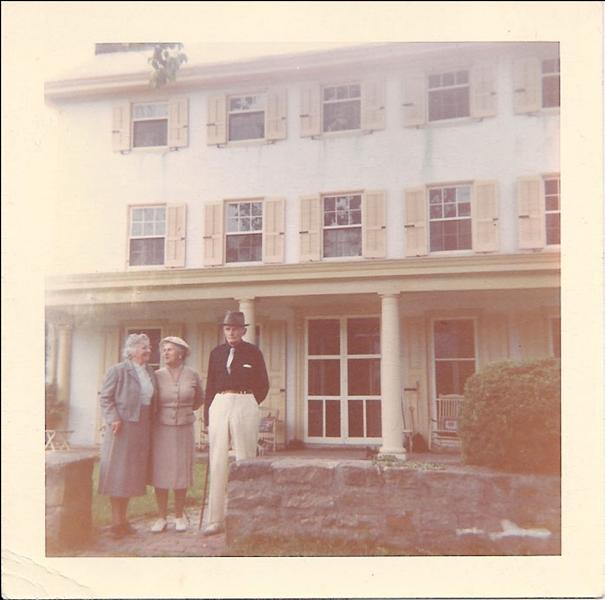
Governor Road, commissioned by Sir William Keith in 1722, bisects the property. At the orginal entrance to the property, there are several features. The first is a three walled ruin, which is believed to be the remains of a barn/ice house dating to 1735. The second feature is a stone marker carved with ’18 M to P’, which probably indicates 18 miles to Philadelphia from that point on Governor Rd. It may be an early mail delivery marker. Directly past the ramp to this barn are two stone gate posts which likely date from the same period.
Governor Road was commissioned to run from Willow Grove directly to Keith’s Estate. This road followed the path of what is now Rt 611 (Easton Road and formerly the Doylestown Turnpike) then made a left near what became the village of Hallowell and ran through what would become the village of Davis Grove, then turned toward the estate. Davis Grove disappeared when the WGNAS was created. The road exists today as a gravel road from the intersection of the driveway to Graeme Park from County Line Road, past the Penrose-Strawbridge farm house, then to the gate at the WGNAS. An extension runs down to Keith Valley Road.
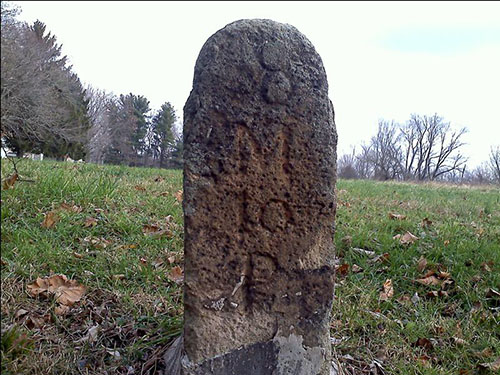
Significance
The significance of the building (Penrose-Strawbridge House) lies with its evolution over the course of the eighteenth and nineteenth centuries. The building also has historical significance for its association with (Sir William) Keith’s original plantation and as a representative example of an expanded colonial home that was modified over two centuries. Although the Strawbridges were good stewards of both houses on the property, their alterations to the Keith-Penrose-Strawbridge House (starting in the 1920s) were not nearly as extensive or significant in scope as those of the Penrose family (beginning in 1801). Therefore, it can be concluded that the building’s primary significance lies with its eighteenth and nineteenth century history, while the significance of its preservation was recognized in the twentieth century. 41
Restoration
Many of the buildings had fallen into a state of disrepair by the time of Mrs Strawbridge’s death. Horsham Township acquired the property in 1997 and allowed HPHA to do research and develop a feasibility study for the restoration of the farm and this was completed in 2001. HPHA’s interest in establishing the lease with the township was in restoring the buildings. The lease includes the main Penrose-Strawbridge House and a number of other buildings, some in fairly good condition, and others that have required or will require a great deal of restoration.
The goal of HPHA is to restore the property to its condition in the late 1800’s. We currently have received designation as a farm, a museum, and a library. The restoration has not progressed to the point where the property is open to the public but we are happy to offer tours by appointment. The house and property are also open during our many events.
The farmstead consists of two houses (the Penrose-Strawbridge House and the Springhouse or Caretaker’s Cottage, a large barn dating to 1839, a well/pump house, equipment barn, carriage shed, stables (razed in 2017), silo and the foundations of a barn/ice house dating to 1735. The remaining acreage is either farmed by a local farmer, forested, or open space. The aerial photo shows part of the current Graeme Park and part of the Penrose-Strawbridge Farm.
The main farmhouse includes the original structure from 1721, major additions by the Penroses through the 1800s, and other modifications by the Strawbridges mostly in the 1920s. The second floor area has been restored and renovated and is used as living quarters for the present caretaker’s family and includes a modern kitchen, bathroom, bedroom, living room and HPHA office space. Most of our restoration work has been focused on this building, so far. The first floor is being restored to earlier periods and is nearing completion in summer of 2018.
A brief history of the farm and the people associated with it below
Keith/Graeme
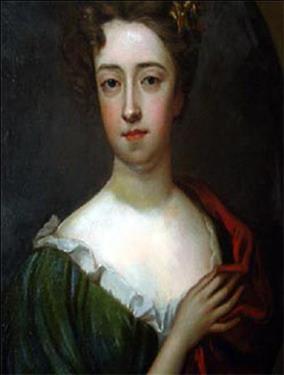
The estate initially known as Fountain Low has a long history. It was initially developed by colonial deputy governor Sir William Keith and then by Keith’s son-in-law. Dr. Thomas Graeme who renamed it Graeme Park.. Keith was a minor nobleman, Baron of Novia Scotia, and had persistent financial problems. 17 year old Benjamin Franklin had a bad experience with him but in his autobiography described him “He wished to please everybody, and, having little to give, he gave expectations. He was otherwise an ingenious, sensible man, a pretty good writer, and a good governor for the people, tho’ not for his constituents, the proprietaries, whose instructions he sometimes disregarded. Several of our best laws were of his planning and passed during his administration.”109 The proprietor, Hannah Penn (widow of William Penn), finally dismissed Keith in 1726. He left the colony, fleeing creditors two years later and died in England.
Dr Graeme acquired Fountain Low in 1739 long after Keith had returned to England. Graeme was a Judge of the Supreme Court, and Port Physician for the city of Philadelphia and was married to Keith’s step-daughter Ann Diggs. Dr Graeme used the estate as a summer residence and entertained many of Philadelphia’s elite there. The interior of the Keith mansion may not have even been finished when he purchased the property, there is speculation that the building may have originally been designed as an industrial building, but Graeme remodeled it to reflect the current English style and taste of the mid 1700s. Elaborate paneling was installed in several rooms and fine marble and imported ceramic delft tiles graced the fireplaces. 125
Graeme’s daughter Elizabeth Graeme Fergusson was called the most learned woman in America and was briefly engaged to the son of Benjamin Franklin. After a trip abroad she introduced the European Literary Salon to the colonies. Graeme Park was used as an encampment for several Revolutionary War armies the winter of 1777-78 including that of Mad Anthony Wayne, and is rumored to have been a place that General Washington was fond of visiting – at least until Elizabeth delivered a letter demanding his surrender. After surviving a threat from the new Commonwealth of Pennsylvania to confiscate the estate (based on Elizabeth’s husband Hugh Fergusson having served as Commissar of Prisoners for the British and her role in the letter to Washington), she sold Graeme Park to her nephew. After her death in 1801 he sold the bulk of the estate to the Penrose family.
Penroses
The Penrose family bought Graeme Park in 1801 and lived in the Keith House until at least 1810 when William and Hannah Penrose added a 3 story addition to an existing cabin just south of the Keith House. This building, which we now call the Penrose-Strawbridge House, became home to successive generations of Penrose’s followed by the Strawbridges in 1920. The Penroses added a second floor above the original cabin in 1830 and a rear kitchen in 1858. The front porch existed in the 19th century but was modified in the 1920s by the Strawbridges.
The Penroses also built two barns around 1839. Both still stand. One is now the Graeme Park Visitor’s center, the other suffered a fire in 1949 and was rebuilt, but smaller. The Penroses also built a springhouse with an attached caretaker’s cottage, a smaller five-bay barn with workers rooms in a second floor above the end bays, and a carriage shed behind this building.

Strawbridges
Welsh and Margaret Marshall Strawbridge purchased the property in 1920 and made major improvements to the farmhouse including adding indoor plumbing and central heating, stables and a pump house. Both Mr and Mrs Strawbridge came from well-established Philadelphia families. Mr Strawbridge, at the age of 40, was a retired financier. They raised thoroughbreds on the farm and he raced in steeplechases, winning 16.
The U.S. Navy had taken over the nearby Pitcairn Field, swallowing up the village of Davis Grove and most of the neighboring Hallowell Farm in the 1940s and after World War II expanded the base and extended the runway to accommodate jets. The Strawbridges gave up some land for this expansion and were afraid of the base encroaching on the historic Keith House – which they and the Penroses had preserved.
The Strawbridges sold (for $1) the portion of the estate now known as Graeme Park to the Commonwealth of Pennsylvania in 1957 to guarantee its preservation. Mr. Strawbridge passed away in 1969. Mrs. Strawbridge, in 1987, sold a half-interest (the other half to be transferred upon her death) in the remaining 102 acres to the National Lands Trust for $1.00 in an effort to preserve the farm and the surrounding land. This agreement allowed Mrs. Strawbridge to live in the house for as long as she liked, and she continued to call the farm home until she died on November 16, 1996. The Natural Lands Trust was not interested in maintaining or restoring the buildings, but Horsham Township was – so on January 8,1997 the Township purchased the Penrose-Strawbridge farm from the Natural Lands Trust, with the stipulation that the property be used for open space and will not be used for further development of the Township. Horsham Township, in 2003, entered into a 25 year lease for 10 acres of this property including the buildings with HPHA for the purpose of restoration.

Movie Set
Remorse/Apparition
The independent movie Apparition (originally titled “Remorse”) was filmed on location at the Penrose Strawbridge House for six weeks in June 2013. About 85 percent of the story is set at the farmhouse with the rest in the Horsham/Hatboro area including Mann Road and at Village Hardware in Hatboro. The film has been available on Amazon Prime and on DVD.
The farm has also been used for a set for a film by students from Drexel University.
The grounds are also popular with photographers and painters. The statue of River Breeze and our Scottish Arch are often used for wedding party photos (Graeme Park next door is a great place for holding your reception!)

… And we’ve hosted a couple WWII Reenactments where our farm pretends to be occupied France and being freed by the good guys.
Undaunted
The Penrose Strawbridge Farm at Graeme Park was also the site for the filming of UNDAUNTED in December 2017. Directed by Matt Strelecki, UNDAUNTED tells the story of a young GI who defies orders and prevents an atrocity during WWII. In December 2018 the film was selected to compete in the Los Angeles’ Indie Short Fest!
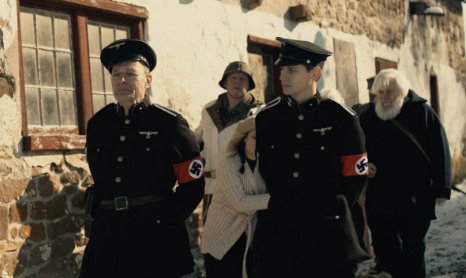
The people who have lived and worked and visited Graeme Park over the past (almost) 300 years are fascinating. Pages for some of them are shown on this site (History/People on the menu). We also have a timeline dating back to 1686 when Samuel Carpenter purchased the original 5000 acre tract from William Penn. This acreage included not only what would become Graeme Park but also most of what would become Horsham Township.
See more about the Penrose-Strawbridge House Restoration
Most of this information came from research by HPHA’s founder and driving force, Margaret Choate. 40
Meet the Founders and Early Settlers of Horsham
Help us preserve Horsham. Learn about membership and sponsorship with HPHA.
Discover the benefits of preservation.
